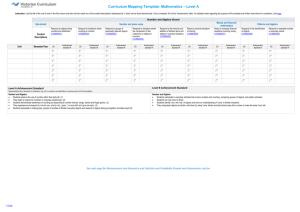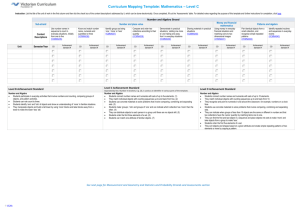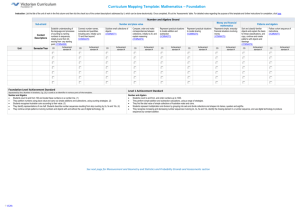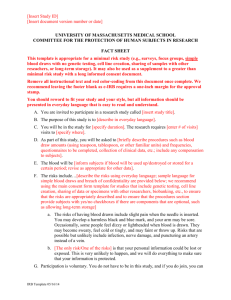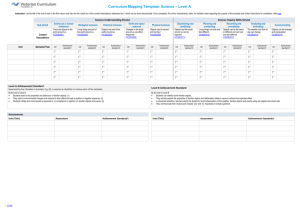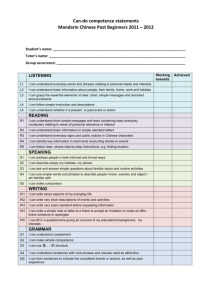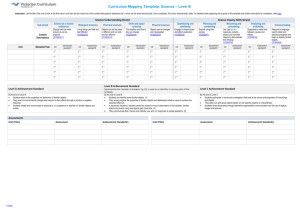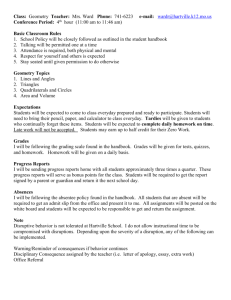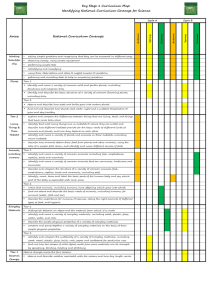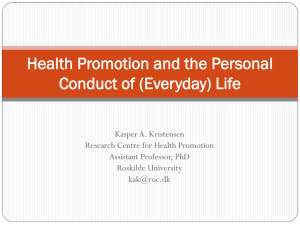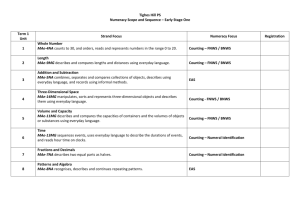Level B (docx
advertisement
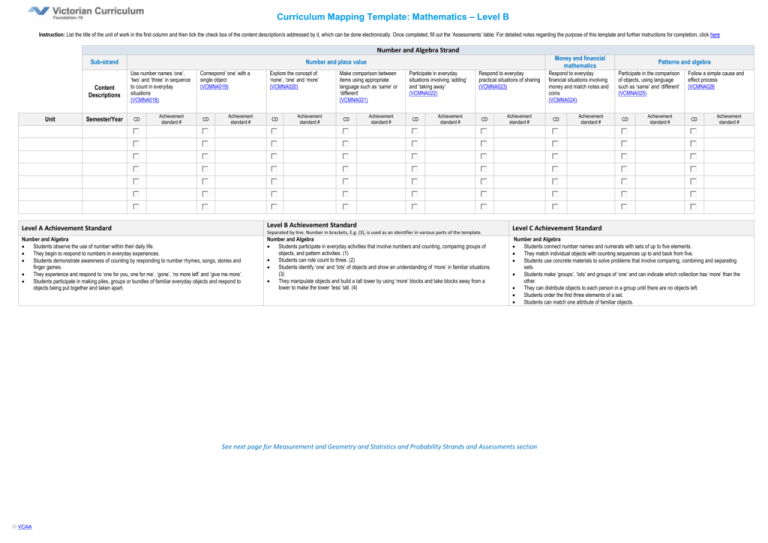
Curriculum Mapping Template: Mathematics – Level B Instruction: List the title of the unit of work in the first column and then tick the check box of the content description/s addressed by it, which can be done electronically. Once completed, fill out the ‘Assessments’ table. For detailed notes regarding the purpose of this template and further instructions for completion, click here Number and Algebra Strand Sub-strand Content Descriptions Unit Semester/Year Money and financial mathematics Number and place value Use number names ‘one’, ‘two’ and ‘three’ in sequence to count in everyday situations (VCMNA018) CD Achievement standard # Correspond ‘one’ with a single object (VCMNA019) CD Achievement standard # Explore the concept of ‘none’, ‘one’ and ‘more’ (VCMNA020) CD Achievement standard # Make comparison between items using appropriate language such as ‘same’ or ‘different’ (VCMNA021) CD Achievement standard # Participate in everyday situations involving ‘adding’ and ‘taking away’ (VCMNA022) CD Achievement standard # Respond to everyday practical situations of sharing (VCMNA023) CD Level B Achievement Standard Level A Achievement Standard Separated by line. Number in brackets, E.g. (3), is used as an identifier in various parts of the template. Number and Algebra Students observe the use of number within their daily life. They begin to respond to numbers in everyday experiences. Students demonstrate awareness of counting by responding to number rhymes, songs, stories and finger games. They experience and respond to ‘one for you, one for me’, ‘gone’, ‘no more left’ and ‘give me more’. Students participate in making piles, groups or bundles of familiar everyday objects and respond to objects being put together and taken apart. Number and Algebra Students participate in everyday activities that involve numbers and counting, comparing groups of objects, and pattern activities. (1) Students can rote count to three. (2) Students identify ‘one’ and ‘lots’ of objects and show an understanding of ‘more’ in familiar situations. (3) They manipulate objects and build a tall tower by using ‘more’ blocks and take blocks away from a tower to make the tower ‘less’ tall. (4) Achievement standard # CD Achievement standard # Participate in the comparison of objects, using language such as ‘same’ and ‘different’ (VCMNA025) CD Achievement standard # Follow a simple cause and effect process (VCMNA026 CD Achievement standard # Level C Achievement Standard Number and Algebra Students connect number names and numerals with sets of up to five elements. They match individual objects with counting sequences up to and back from five. Students use concrete materials to solve problems that involve comparing, combining and separating sets. Students make ‘groups’, ‘lots’ and groups of ‘one’ and can indicate which collection has ‘more’ than the other. They can distribute objects to each person in a group until there are no objects left. Students order the first three elements of a set. Students can match one attribute of familiar objects. See next page for Measurement and Geometry and Statistics and Probability Strands and Assessments section © VCAA Respond to everyday financial situations involving money and match notes and coins (VCMNA024) Patterns and algebra Curriculum Mapping Template: Mathematics – Level B Strand Measurement and Geometry Sub-strand Content Descriptions Unit Semester/Year Using units of measurement Compare objects using direct comparison (VCMMG027) CD Achievement standard # Recognise and participate in familiar events that happen on a daily basis (VCMMG028) CD Achievement standard # Participate in regular daily events (VCMMG029) CD Achievement standard # Identify when two shapes or objects are the same sort or not (VCMMG030) CD Achievement standard # Assessment CD Achievement standard # Measurement and Geometry Students participate in everyday activities that explore measurement and use measurement attributes in practical situations. (5) Students demonstrate beginning understanding of basic measurement concepts such as ‘long or short’, ‘heavy or light’. (6) They explore routine events and show an awareness of time and daily routines by responding to a routine signal from the teacher. (7) They demonstrate an awareness of object permanence by searching for objects that have been hidden and participate in class activities that explore three-dimensional objects. (8) They can match identical familiar three-dimensional shapes that are ‘the same’. (9) Students respond to specific instructions relating to manipulating the movement and location of self and objects. (10) Statistics and Probability Students participate in class activities that explore object, events and displaying information. (11) They develop an awareness of chance by playing with materials or objects that involve cause and effect (actions that will happen) and playing games where the outcome is unpredictable. (12) Students respond to a simple pictorial representation of their activities related to a short time-frame. (13) Achievement Standard/s Unit (Title) Page 2 Data representation and interpretation Respond to a simple statement about location or direction (VCMMG031) Separated by line. Number in brackets, E.g. (3), is used as an identifier in various parts of the template. Measurement and Geometry Students observe and explore objects within daily life. They react and respond to objects and experience measurement attributes in practical situations. Students explore objects of varying weights, lengths, capacities and materials. They show an awareness of time and daily routine by responding to a signal from the teacher, and items being brought out or removed. Students respond to a signal from a timer, used to indicate the end of an activity. Students explore and respond to objects of varying textures, colours, sizes and shapes. Students explore space by moving and changing position and location, and respond to changes in position. Statistics and Probability Students observe objects and events within their daily life. Students begin to display a similar and predictable reaction to regular events. They respond to major changes to regular games and activities associated with chance, surprise and predictability, such as moving a switch to activate a toy. © VCAA Shape Level B Achievement Standard Level A Achievement Standard Assessments Unit (Title) Statistics and Probability Location and transformation Participate in data collection (VCMSP032) CD Achievement standard # Participate in the grouping of data (VCMSP033) CD Achievement standard # Experiencing data being used for decision making in everyday situations (VCMSP034) CD Achievement standard # Level C Achievement Standard Measurement and Geometry Students explore measurement attributes in practical situations and use words to describe the characteristics of familiar objects. Students solve simple mathematical problems associated with longer and shorter lengths. They explore events and identify day and night events. They can identify events that may or may not happen today. Students respond to a simple pictorial representation of activities related to their whole day. They match objects that are the same and sort familiar objects, and an understanding of the concept of ‘inside and outside’ by following instructions. They demonstrate an understanding of location and spatial awareness by following simple instructions related to simple spatial concepts. Statistics and Probability Students participate in and contribute to the development of picture schedules, timetables and pictorial lists associated with familiar activities, such as listing the ingredients needed for a cooking session. They demonstrate an understanding of the concept of chance by participating in games of chance, and identifying events that may or may not happen today. Assessment Achievement Standard/s
